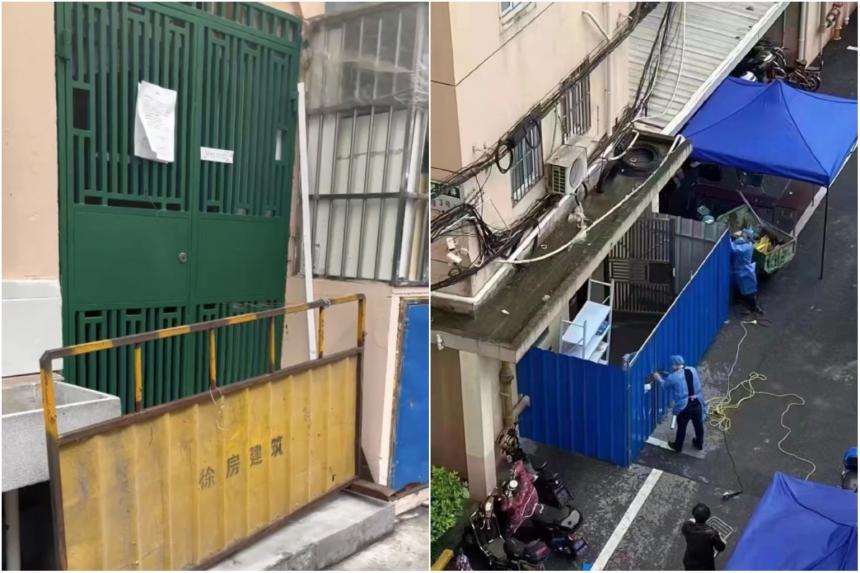SHANGHAI, (Reuters) – Shanghai authorities battling an outbreak of COVID-19 have erected fences outside residential buildings, sparking fresh public outcry over a lockdown that has forced much of the city’s 25 million people indoors.
The largest district in Beijing, meanwhile, will require everyone living or working in the area to take three COVID tests this week, and put more than a dozen buildings under lockdown, after the Chinese capital reported 22 new cases for Saturday. The district, Chaoyang, is home to 3.45 million people.
In Shanghai, images of workers in white hazmat suits sealing entrances of housing blocks and closing off entire streets with green fencing – roughly roughly two metres tall – went viral on social media, prompting questions and complaints from residents.
“This is so disrespectful of the rights of the people inside, using metal barriers to enclose them like domestic animals,” said one user on social media platform Weibo.
One video showed residents shouting from balconies at workers trying to set up fencing. The workers relented and took it away. Other videos showed people trying to pull fences down.
“Isn’t this a fire hazard?” asked another Weibo user.
Many of the fences were erected around compounds designated “sealed areas” – buildings where at least one person tested positive for COVID-19, meaning residents are forbidden from leaving their front doors.
It was not clear what prompted authorities to resort to fencing. A notice dated Saturday from one local authority shared online said it was imposing “hard quarantine” in some areas.
Reuters was not able to verify the authenticity of the notice or all of the images, but saw green fencing on a street in central Shanghai on Sunday.
In recent days, Reuters has also seen police in hazmat suits patrolling Shanghai streets, setting up road blocks and asking pedestrians to return home.
The Shanghai government did not respond to a request for comment.
MISERY
Shanghai is China’s most populous city and most important economic hub. It is battling the country’s biggest COVID-19 outbreak since the coronavirus first emerged in Wuhan in late 2019 with a policy that forces all positive cases into quarantine centres.
The lockdown, which for many residents has lasted over three weeks, has fuelled frustration over lost wages, family separation and quarantine conditions as well as access to medical care and food.
Supermarket Freshippo, backed by Alibaba Group Holding Ltd 9988.HK, said on Sunday it was adding couriers to meet demand in the city.
The lockdown has also dragged on China’s economy, the world’s second-largest, with factory production disrupted by snarled supply chains and difficulties faced by locked-down residents returning to work.
Shanghai is carrying out daily citywide COVID tests and accelerating transfer of positive cases to central facilities to eradicate virus transmission outside quarantine areas.
In the past week, authorities have also transferred entire communities, including uninfected people, saying they need to disinfect their homes, according to residents and social media posts.
Many residents have vented on the internet about the lockdown and express dissent, using euphemisms and other means to battle government censors who often remove content critical of the authorities.
Videos of “Do You Hear The People Sing?”, a protest anthem from “Les Miserables”, have been widely reposted, with the title of the French musical receiving over 90 million mentions on WeChat on Saturday, the chat app’s data showed.
DEATH TOLL
Shanghai reported 39 COVID deaths for April 23, versus 12 a day earlier and by far the most during the current outbreak.
It did not report any deaths in the first few weeks, fuelling doubt among residents about the figures. It has since reported 87 fatalities, all in the past seven days.
The city recorded 19,657 new locally transmitted asymptomatic cases, versus 20,634 a day prior, and 1,401 symptomatic, versus 2,736.
Cases outside quarantined areas totalled 280 from 218 on the previous day. Other cities that have been under lockdown began easing restrictions once cases hit zero.
China largely succeeded in keeping coronavirus at bay following the Wuhan outbreak, with a “dynamic zero” policy aimed at stamping out chains of infection.
That approach has been challenged by the spread of the highly infectious but less deadly Omicron variant, which has prompted cities to impose various levels of restrictions on movement.
Nationwide, China reported 20,285 new asymptomatic coronavirus cases for Saturday, versus 21,423 a day earlier, with 1,580 symptomatic cases, versus 2,988.

